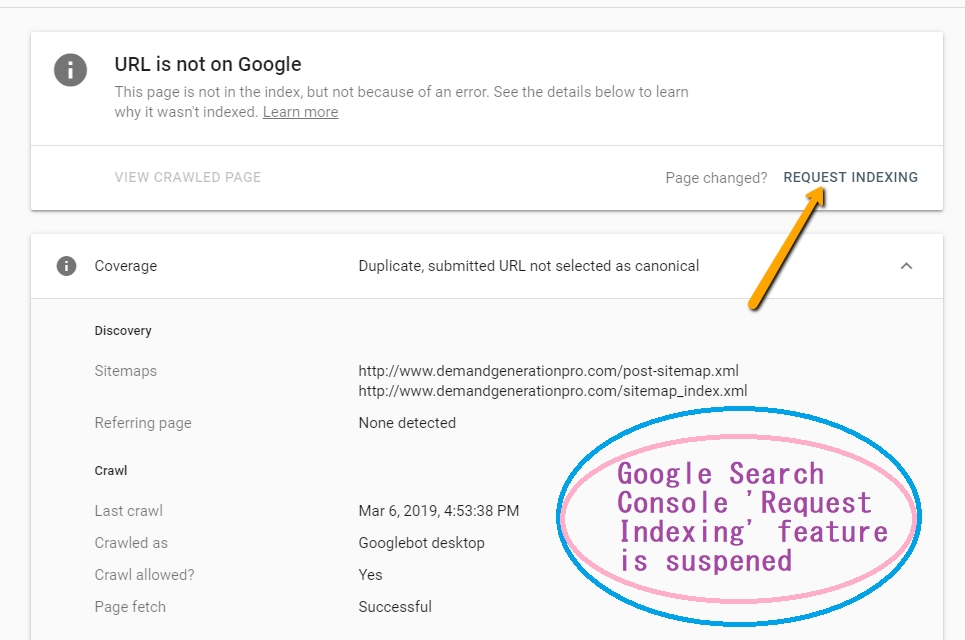Google Search Console temporarily suspended request indexing feature.
Whenever a webmaster publishes an article, he makes sure that the content is visible on Google, right. For that, he takes help of a URL inspection tool within Google Search Console, which is an important element of SEO. If you operate a website, you would know that ‘Request Indexing’ is the feature of the URL inspection tool through which you ask Google to index your site content. After indexing, your content becomes visible on Google’s SERPs. This is kinda important process for every webmaster and SEO to follow for their site to rank on Google. But shocking news has come from Google about indexing. You know what’s that? Recently, Google announced that it has temporarily disabled the ‘Request Indexing’ feature within Google Search Console. Shocking no?

I know you would be curious to read more on this news, right. In this article, I will talk about the ‘Request indexing’ feature and when it will enable again for webmasters.
Let’s jump in.
Google Temporarily Disabled Request Indexing Feature in Search Console
About a few days ago, news from Google became prominent in the web world about disabling the ‘Request Indexing’ feature of the URL inspection tool within Google Search Console. This news webmasters got to know from Twitter where Google wrote, “We have disabled the “Request Indexing” feature of the URL Inspection Tool, in order to make some infrastructure changes. We expect it will return in the coming weeks. We continue to find & index content through our regular methods, as covered here.”
The question is why Google is disabling the request indexing feature? From the statement of Google, it is clear that Google is suspending the feature for making some infrastructure changes.
What is the objective of the request indexing feature in Google Search Console?
Request indexing feature in the URL inspection tool under Google Search Console aid you to appear your pages on Google Search Results pages (SERPs) and also helps you rank on Google. So when you request Search Console for indexing your page, it will then show your pages on Google, but there is no such guarantee. Moreover, it is used to request a crawl of individual URLs.
With proper indexing, you manage your site content on Google and it also helps Google to discover your content. This is the first process of indexing the content.
Let’s move little further and know the reason of disabling indexing feature.
Why Google is disabling indexing feature from Search Console?
The reason for disabling the indexing feature is that a lot of complaints were coming from SEOs and webmasters about indexing bug issues. Also that Google is not indexing the content properly. Due to which a lot of SEOs are quite upset with the state of Google Search and indexing process. It seems that there has been a bug problem occurring in Search Console but this is also not yet confirmed from Google. A lot of issues increased with Google search results.
Therefore, Google’s infrastructure changes will lead to some improvements for SEOs and webmasters. So this is the reason why Google is suspending the indexing feature for the next few weeks.
If you currently submit your site URL for indexing, will it accept?
Guys, if you currently use the request indexing feature, it will not index your site URL as of now. However, Google said it will continue to index your site through normal crawling and indexing. Let me also tell you that even if the feature is working it does not guarantee immediate indexing. In some cases, Google chooses to index your site URL, not at all.
In the Search Console help page, the company states, “Requesting a crawl does not guarantee that inclusion will happen instantly or even at all. Our systems prioritize the fast inclusion of high quality, useful content.”
So yes, SEOs and site owners can afford to temporarily live without request indexing feature, isn’t it.
Is there any alternative which Google offers for request indexing feature?
Do you think Google offers an alternative for the request indexing feature? If you think so then you are right. Here are three methods you can use as of now for indexing your site URL. Read them one by one below.
1. Use Passive Approach
So Google Search Console says that if you have a website without having a sitemap, the system will automatically attempt to find and index your site if you don’t block your content from the crawler. The only thing you need to do here is produce quality content. This method is great for those who have a simple website and don’t do timely content discovery in Search Console.
2. Actively Manage your URLs
In this method, you provide a list of URLs to your content which is termed as sitemap. This helps and speeds up the system to discover your content. You just need to host the sitemap on your domain in a place accessible by Googlebot. This approach will enhance the performance of your rich results in Search. Moreover, the method will also improve the obstacle for getting your content quickly served by Google in many ways.
3. You can also submit new and updated URLs to Google
The last alternative you have is submitting your new and updated URLs to Google. Here you only need to provide notifications about new URLs or existing URLs that have changed content. Submitting new URLs on a sitemap will help quickly discover them. For existing URLs, you can provide an XML sitemap to let the system know that your changed content is ready for re-indexing.
When will Google enable the request indexing feature?
Let me tell you that the Google webmaster team has clearly stated that the suspension of the request indexing feature is temporary. And it will again get resume in the coming weeks shortly. Until then Google Webmasters Team will index content in the usual ways.
Final track
Site indexing is one of the most crucial parts of SEO in the digital marketing world. Not getting site indexed means no visibility or site rank on Google. But what Google has done by disabling the request indexing feature is making infrastructure changes to it. There are some alternatives which Google has offered for you to use until the request indexing feature come into force.
Till then keep reading our newly published articles, and don’t forget to subscribe to our website.


